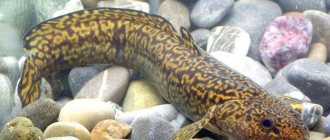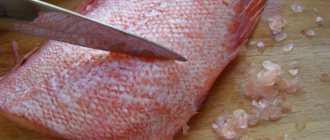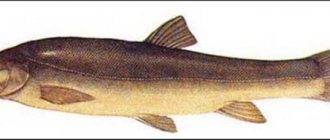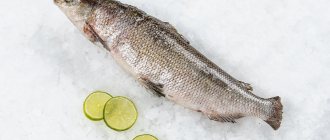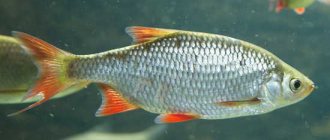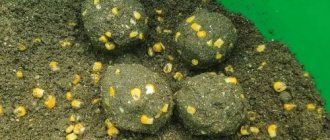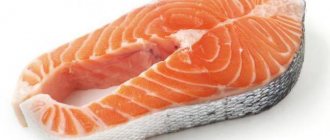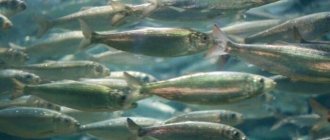North America is considered to be the homeland of the sunfish; it was from there that this rainbow fish was first imported. At the very beginning, it was used exclusively for decorative purposes; it decorated fountains and artificial ponds in the estates of the nobility. And later she came to the Danube, where she lives to this day. For its special endurance and unique appearance, it is also loved by aquarists.
This type of fish is great for decorative purposes.
Habitat in nature
There are 30-35 freshwater species of sunfish (family Centrarchidae) in the world, found in Canada, the United States and Central America.
The sunfish's natural range in North America extends from New Brunswick down the East Coast to South Carolina. It then travels inland to the middle of North America and extends through Iowa and back through Pennsylvania.
They are found primarily in the northeastern United States and less commonly in the south-central or southwestern regions of the continent. However, the fish was introduced to most of North America. They can now be found from Washington and Oregon on the Pacific coast to Georgia on the Atlantic coast.
In Europe it is considered an invasive species because, when exposed to suitable conditions, it quickly displaces native fish species. Populations have been recorded in Hungary, Russia, Switzerland, Morocco, Guatemala and other countries.
They usually live in warm, calm lakes, ponds and streams, small rivers with plenty of vegetation. They prefer clean water and places where they can find shelter. They stay close to the shore and can be found in large numbers on shallow reaches. They feed at all water levels from surface to bottom, most intensely during the day.
Sunfish typically live in schools, which may also include other related species.
Groups of young fish stay close to shore, but adults tend to move in groups of two to four into deeper water. Perch are active throughout the day, but rest at night near the bottom or in protected areas near snags.
Fishing
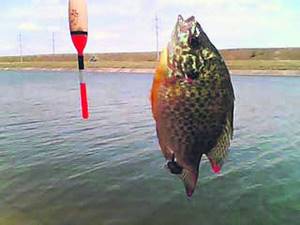
Despite its small mouth, this greedy fish swallows even the fry of other inhabitants of the reservoir. Based on this, experienced fishermen use large hooks of a fairly large number - tenth - when catching American perch. The best treat for this fish is maggot , although when fly fishing with dry flies it swallows the hook almost completely. It must be said that some consider the sunfish to be a “trash” fish, which, quickly multiplying, begins to destroy the eggs of more valuable commercial species, thereby causing harm
Fishing object
Sunfish tend to bite on worms and are easy to catch while fishing. Many anglers consider it a trash fish because it bites easily and often when the fisherman is trying to catch something else.
Because bass stay in shallow water and feed all day, the fish are relatively easy to catch from shore. They will bite even the largest bait - including garden worms, insects, leeches or pieces of fish.
But, sunfish are very popular with young fishermen because of their willingness to bite, their abundance and their proximity to shore.
Although people think the fish tastes good, it is not popular due to its small size. Its meat is low in fat and high in protein.
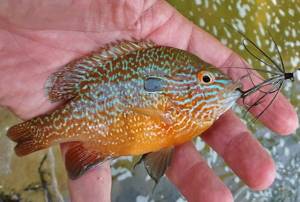
Reproduction
Glass perch reach sexual maturity at six months of age. It is from this moment that the males begin to look for secluded places for spawning. They drive away other males and persistently invite females to spawn. The duration of this process is four days, during which the pair spawns many times. The female lays up to six eggs at a time, after which the male immediately fertilizes them. During spawning, up to three hundred eggs appear. The duration of the incubation period is about one day. The larvae remain on the plants for three to four days, after which they begin to swim. They need to be fed with microworms, ciliates, and green water. After two weeks, the fry begin to be fed with Artemia nauplii.
Description
The oval-shaped fish with a golden-brown background flecked with iridescent blue and green spots rivals the beauty of any tropical species.
The spotted pattern gives way to blue-green lines around the head, and the gill cover has a bright red edge. Orange spots may cover the dorsal, anal and caudal fins, and the gill covers have blue lines across them.
Males become especially colorful (and aggressive!) during breeding season.
Sunfish are usually about 10 cm long, but can grow up to 28 cm. They weigh less than 450 grams, and the world record is 680 grams. The record fish was caught by Robert Warne while fishing on Lake Honoai (New York State).
Sunfish live up to 12 years in captivity, but in the wild, most do not live more than six to eight years.
The fish has developed a special method of defense. There are 10 to 11 spines along its dorsal fin, and three more spines on its anal fin. These spines are very sharp and help the fish protect itself from predators.
They also have a small mouth with an upper jaw that ends just below the eye. But in the southernmost reaches of their range, sunfish have developed larger mouths and abnormally large jaw muscles.
The fact is that their food there is small crustaceans and mollusks. The larger bite radius and strengthened jaw muscles allow the bass to crack the shell of its prey to reach the soft flesh inside.
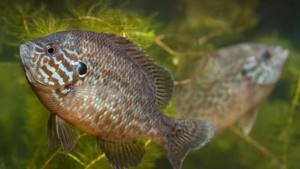
Glass perch (Parambassis/Chanda ranga)
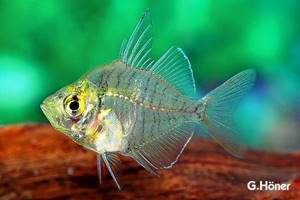
Glass perch (Parambassis/Chanda ranga)

Habitat:
inhabits stagnant bodies of brackish and fresh water in India, Burma, Pakistan, Malaysia, Bangladesh, Thailand, Nepal and Cambodia.
Description:
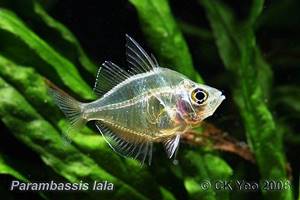
The tall body is diamond-shaped, flattened laterally. The back is arched. The lower jaw is elongated, the teeth are small, the forehead is concave. The dorsal fin consists of 2 parts: the front is triangular in shape and high, the back is more rounded at the bottom, the anal fin is symmetrical to it.

The body is so transparent that the internal organs and skeleton are visible through it. The noticeable swim bladder of the male is pointed and elongated, while that of the female is more rounded. There are 5 rays on the ventral fin, 7-8 spines on the dorsal fin, three on the anal fin, and one spine on the ventral fin.
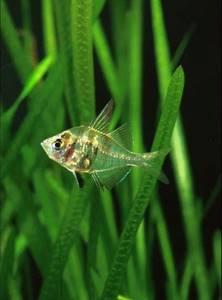
The color of males ranges from yellow-green to yellow-orange with five transverse stripes on the sides formed by dark spots. The rays on the fins are black with a blue rim.
Glass perch - female
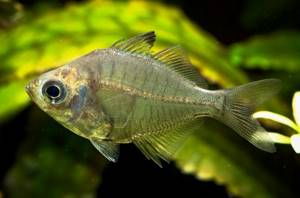
The color of females is less remarkable. They lack a blue border on their fins and have a steel-silver body.
Glass perch - male
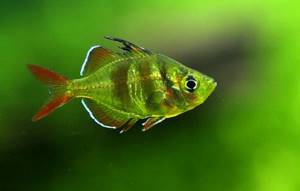
The tip of the anterior dorsal fin is dark. The pectoral fins are reddish in color. Some individuals have a light purple stripe stretching from the gills to the caudal fin.
Glass perch - painted
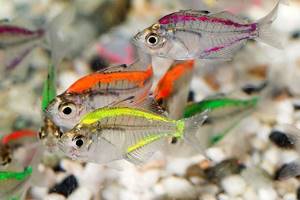
In nature, glass perch reaches 8 cm, in captivity - 5 cm.

Arrangement and parameters of the aquarium:
an aquarium needs to be at least 100 liters or at least 50 cm long. Fish feel most comfortable when kept in a school of 5-8 individuals.

Any type of plant that can grow in salted water is suitable. It is better to plant them in containers rather than in soil, which should be shallow. Sand or gravel of a small fraction is suitable. Fish require free space for swimming and secluded places, which form piles of large stones, snags or artificial grottoes.

Water parameters:
23-26° C, dH 8-20, pH 7-8.5.

Good filtration with aeration is necessary. Water changes are carried out in small quantities. Glass perch like old and very clean water. It is useful to add sea salt to the aquarium (3 tsp per 10 liters). The lighting is bright, it is desirable that sunlight enters the aquarium.
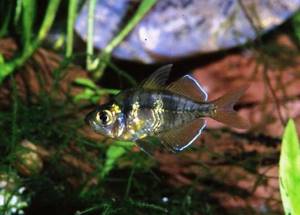
Glass perch (Parambassis (Chanda) ranga)
A very peaceful fish, which, however, is sensitive to a large number of neighbors. Compatible with small species: guppies, tetras, rasboras, corydoras. Can't be kept with large aggressive fish.

Nutrition:
in nature it eats crustaceans, worms, and insect larvae. In an aquarium, glassfish should be fed frozen and live food. The daily norm is divided into small portions and fed gradually. He does not accept cereal readily.
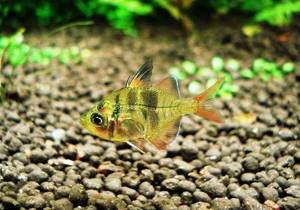
Reproduction:
For a pair of glass perches you will need a spawning tank from 50 cm, for several pairs - from 80 cm. Small-leaved plants, including floating ones, are placed in the container. Their number should be greater than the number of males.
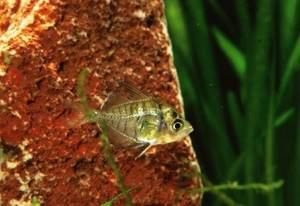
A few months before spawning, the water must be salted: for 12 liters - 2 tsp. Spawning is stimulated by raising the temperature a few degrees, adding one-fourth of fresh water and the light of the morning sun.
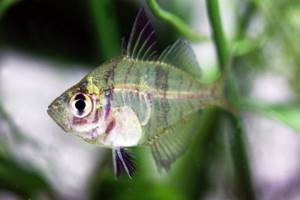
The fish spawn at dawn, gluing eggs to the leaves, roots and stems of plants. The female lays 6-10 eggs at a time. During the entire spawning period, which lasts 2-3 days, she lays about 200 eggs. The fish do not eat their offspring and therefore there is no need to remove them.
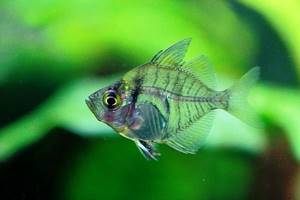
Incubation lasts from 1 to 2.5 days. At first, the hatched fry hang motionless in a vertical position, and then swim and are able to receive nauplii and rotifers. The spawning area with fry should be dimly lit around the clock. You should carefully monitor the purity of the water, making drip changes.
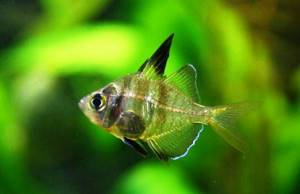
They become sexually mature at 4-6 months.

Lifespan of Glass Perch (Parambassis (Chanda) ranga)
- up to 3 years.

Keeping in an aquarium
Unfortunately, there is no reliable information about keeping sunfish in an aquarium. The reason is banal: it, like other local fish, is rarely kept in aquariums even by the Americans themselves.
There are enthusiasts who successfully keep them in aquariums, but they don’t talk about the details. It is safe to say that the fish is unpretentious, like all wild species.
And that it needs clean water, because it is in such conditions that it lives in nature.
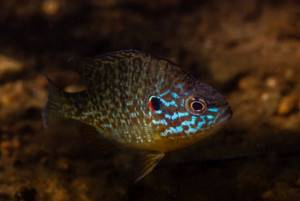
Is it possible to eat sunfish
What to catch perch with
You can eat sunfish. The meat of this fish has excellent taste and can be prepared in various forms. Especially good is the freshly caught “rainbow”, which is baked in foil over a fire. After freezing, fish loses its original taste characteristics. California grouper can be prepared in different ways:
- fry;
- smoke;
- dry;
- cook fish soup from it.
Thanks to the thick skin, juice does not leak out of the fish during cooking. The only disadvantages include the high bony nature of the sunfish.
Feeding
In nature, they feed on a variety of small foods both on the surface of the water and on the bottom. Among their favorites: insects, mosquito larvae, small molluscs and crustaceans, worms, fry and even other small perches.
They are known to feed on small crayfish and sometimes small pieces of vegetation, as well as small frogs or tadpoles.
Sunfish that live in waters with larger gastropods have larger mouths and associated muscles for breaking the shells of larger gastropods
In the aquarium they are also carnivorous and prefer to eat insects, worms and small fish.
Americans write that newly caught individuals may refuse unfamiliar foods, but over time they can be trained to eat fresh shrimp, frozen bloodworms, krill, cichlid pellets, cereal and other similar products.
Compatibility
Peaceful and harmless fish, perches themselves can become victims of predators. They are shy and stick to shelters. These small fish only live in schools and need to be kept at least six in an aquarium to feel safe.
A single person or a couple will feel stressed and hide. As already mentioned, before purchasing, find out what kind of water they were kept in, and ideally, see how they eat.
If you're willing, you can take it. And remember, it is better to introduce glass perches into an already established aquarium rather than into a newly launched one, as they are quite capricious.
Suitable neighbors for them would be zebrafish, cuneiform rasboras, small barbs and irises. However, the selection of neighbors also depends on the salinity of the water.
In the brackish water it can be kept with mollies, bee goby, but not with tetradons. They get along well with peaceful catfish, such as corydoras, and shrimp.

